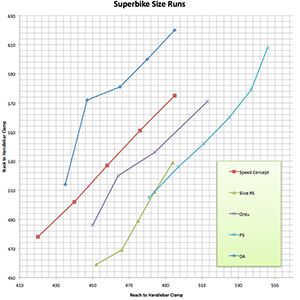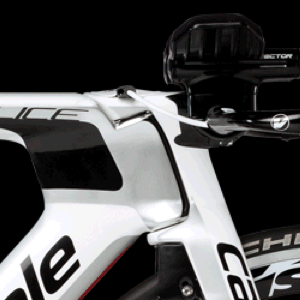How do Superbikes Fit?

Superbikes are, according to us, bikes that have their front ends integrated. They have proprietary stems, and they may have propriety aerobars. Examples of propriety stems on superbikes can be found on Felt’s DA or in the Specialized Shiv or on Cannondale’s Slice RS. These bikes have stems that are an integral part of the bike, but they accept standard aerobars.
Trek’s Speed Concept is another animal altogether. The 9 Series version of this bike has the entire handlebar integrated. When this happens, and the 3T Aduro bar aboard Cervelo’s P5 is another case in point, discussing stem “lengths” is not straightforward. Indeed, sometimes you’ll hear the designers of these bikes talk as if stem length is no longer a valid metric. That’s true, to a point. However, it’s also true that where the pads sit, and where the pursuit position sits, in height above the place where the bar affixes to the fork steer column, and in the protrusion in front of the steer column, matters.
I found myself wondering what the geometries of these superbikes really are, for fit purposes, and how they compare to standard bikes. I'll bet many of you thought the same thing. So, for the purpose of this exercise, I took the shortest, lowest proprietary stem available on all these bikes, and I charted the “X” and the “Y” dimension from the bottom bracket to the handlebar clamp. Now, what about the Speed Concept 9 Series? There is no handlebar clamp! True. However, that same Bontrager aerobar that goes on the bike has a very close analog sold in the aftermarket that affixes to a standard stem. It occurred to me that if I measure from the pad on this aftermarket Bontrager forward and down to the center of the handlebar clamp, where the pursuit bar passes through it, this gives me a handy metric. Measuring forward and down that same distance on the integrated 9-Series version handlebar gives me a “virtual” handlebar clamp center. Measuring back to the steerer gives me then both a length and a height above the head tube top.
I then plotted, on each of these superbikes below, the height and the length of these bikes on a cartesian-style chart. The vertical axis is BB to handlebar clamp. The X axis is the horizontal distance to the same place. What’s interesting is to me is that some of these proprietary stems conspire to make the bike very low. I think the most strident example is the Cannondale Slice RS.

The Slice is represented on the green line. Each dot on that line is a size in the size run. Note how the tallest that bike ever gets, in its largest size, is about the same height as the Speed Concept 9 series in its middle size. The Slice RS is not only not a very tall bike, it’s only middlin' long. To put it another way, it starts fairly long, but it never gets that much longer. It’s fairly long in its smallest size — about the same length as Orbea’s new Ordu. However, the size run is tight in the Slice RS. There are not big differences between each size. You could make a pretty strong argument that the Slice RS, in its two largest sizes, are almost equivalent to Cervelo’s P5 in its two smallest sizes!
Now, let me explain something. One of the reasons why the P5 is long compared to, say, Felt’s DA, is that I’m comparing each bike in each bike’s smallest and lowest available stem. The DA’s lowest easily available stem is not very low, and it’s not very long. The 3T Aduro bar is about equal to a standard 100mm long stem. There is no Aduro stem option shorter than that. The DA has a very short stem available. In point of fact, Felt’s DA and Cervelo’s P5 are almost identical frames in terms of how they fit. The stack and reach of the entire size runs of both frames are almost identical. It’s the front ends of these bikes — these proprietary stems — that cause them to differ.
It’s also important to note that Felt not only makes a longer proprietary stem that will cause the DA’s size run to almost match the fit metrics of the P5 — when stem length and height is factored in — the DA also has a hinged stem available on that Bayonet 3 fork and this greatly increases its range of fit. Likewise, the Aduro bar has three height options: low, medium and that big sexy V that looks like Claudia Cardinale’s cleavage, which is only proper since 3T and Claudia Cardinale are both Italian and each has attributes very easy on the eyes.
One more thing about the Felt DA. You can get a very low one-piece stem for that bike. If you take the Felt's lowest, shortest, easily obtainable stem size for that bike, and you replace it with a very low, flat stem that I have seen kicking around, you get a fit profile for that bike that just about exactly matches the Speed Concept 9-series with that bike's lowest profile proprietary stem.
The point here is that these superbikes take on a whole new personality versus the standard versions of these bikes. For example, Cannondale’s standard Slice is what we call a moderately “narrow/tall” bike in terms of how it fits. It’s got a lower reach number and a taller stack number throughout its size run than, say, a Cervelo P2 or a QR Illicito or the Boardman that Pete Jacobs rode to victory in Kona. But the Slice RS! It couldn’t be more different.
It’s the same story, but to a less strident degree, when comparing Speed Concepts throughout the series. The 7 Series features the same frame silhouette. Fits the same as the 9 Series, right? Well, yes and no. The lowest height option of the 9 Series' three available integrated bar/stem options is lower than you’re ever going to be able to get with a standard headset top cap and stem config. So, the 9 Series is really a lower bike than the 7 Series or, at least, it can be.
Let’s look at how these superbikes compare to standard bikes.

This chart is the same as the chart above but with two additions: The size runs of Felt’s new B series models for 2013 (which is different than the prior B series models) and also the size run of the P2. Now, I’ve tried to be apples-to-apples here, so I’ve chosen to “virtually configure” these standard bikes with very low front ends. The size runs of these two popular bikes are outfitted with 20 total millimeters of space between the head tube top and the stem, and that would include the bike’s headset top cap plus any additional spacers. 20mm is not much. The stem I’ve chosen is a –17° (parallel to the ground) 90mm long stem. This front end is probably lower than you’re riding on your existing tri bike.
Note that the P2 is just about as tall as the Felt DA throughout its size run, and the B12 grows, by its largest size, much taller than both. Indeed, if you put the longer of the two available lengths of DA proprietary one-piece stems, that would stretch the DA out and make it almost a match with the P2 using this fairly low front end. The DA is a superbike that fits like a fairly standard — albeit slightly low — bike. The Ordu fits slightly lower than this, rather in line with the Speed Concept 9 Series. Keep in mind that the two stem lengths available on the 9 Series rough out to about 50mm long and 100mm long. The shortest of the Ordu’s virtual stems is 75mm and, lo, it fits (lengthwise) just about in between where the 9 Series Speed Concepts two stems would place your rider position. In other words, if the Speed Concept 9 Series had a stem precisely in between its "low/near" stem and its "now/far" stem, that bike would fit, almost precisely to the millimeter in height and length, where the new Ordu sits with its 75mm stem.
So, the new Ordu and the Speed Concept are geometrically similar, fitwise, except the Speed Concept has more sizes. I rather like the additional size options in the Speed Concept, but I think I like some of the Ordu’s stem options better, in terms of fit. The Speed Concept 9 Series has 6 stems available, two lengths and three heights, but the tallest of the heights is too tall. You’d just be better off getting the next size up Speed Concept.

The real outlier here is the Slice RS. Its size run is 50, 52, 54, 56 and 58. But really the sizes are more like 47, 50, 51, 52 and 53. This does not make it a bad bike. Far from it. I love this bike. Just, I love it for people up to about 5’10”. Now, to be sure, you could be taller and ride this bike. The bike adjusts longer, up to about 110mm of stem length. But, height? You’d have to get that out of the handlebar. You’d almost certainly need a higher profile aerobar, with pads that can pedestal up pretty tall. This would leave you with a pursuit position pretty low. That’s fine, just make sure that’s what you want. Again, this is if you’re a taller fellow. If you’re 5’10”, maybe 5’11”, the bike’s mighty low, but certainly on the acceptable side. But if you're 6 feet tall or taller I start to wonder whether the bike can be gotten tall enough and long enough. It’s got a front center of about 63cm in size 58cm, so there’s enough bike below you to support you if you’re 6’ or 6’1”.
On balance, on average, these superbikes are lower than are their standard bike cousins. Part of this is just the lack of a need for a headset top cap on these bikes. But part of it is due to a trend: the cutting out of the top tube from above, creating a nest for the stem to sit. (The pic of the Slice RS just above is a case in point.) This lowers the bike. That, along with no top cap, lowers the front end. If you don’t make accommodation to raise that front end back up through armrest pedestals then the bike is just going to be lower. Even if you do pedestal the armrests, the pursuit bars are still down there somewhere distant. This is good for time trialists, for whom the pursuit position is a sprint position. It’s the “hooks” on your road bike. But a lot of you like that pursuit position to be a little more like the “hoods.”
This isn’t good or bad. It just is. Know that if you want one of these new superbikes, they’re not necessarily going to be like their standard bike cousins. I’ll be writing about all of them, and if you wonder why I haven’t included more here today —such as the Shiv and the BMC TM01 — I’m still aggregating fit data on these bikes.
If you’re wondering how I calculated these front end metrics, some of it is made easier by some tools we’ve recently made for the fitters we train, and whose proficiency we help to equip via continuing education. The X and Y of front end configs is determined easily by our F.I.ST. Stem Calculator and we move back and forth between handlebar clamp X/Y and frame stack and reach via a F.I.ST. Handlebar Bore Calculator.






Start the discussion at forum.slowtwitch.com